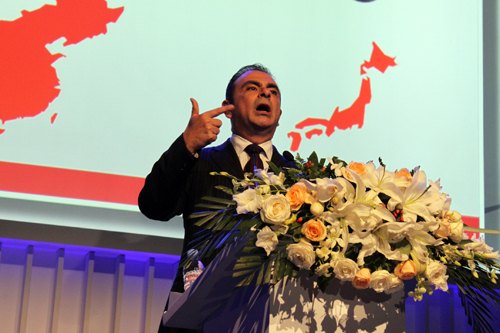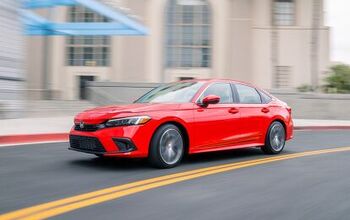With Carlos Ghosn In Beijing: Go Where The Growth Is

In fulfillment of my paparazzo duties, I stalked Nissan’s and Renault’s CEO all the way to China today. Easy for me to do: I could walk from where I live in Beijing. The walk was worth it. In the Grand Ballroom of the China World Tower 3, Ghosn and his Chinese joint venture partners announced an aggressive five year plan. Nissan and Dongfeng want to nearly double Nissan sales in China from 1.3 million in 2010 to 2.3 million in 2015.
The plan is less ambitious than it sounds. Currently, Nissan has 6.5 percent market share in China. “Our objective is 10 percent market share,” said Ghosn. That means that they budget for a total market of 23 million in 2015, up from 18 million last year. China-watchers think this is very conservative.
To reach that goal, the joint venture has to build a lot of capacity. Underscoring that the 2.3 million are not just targets nobody takes seriously, current plants are being expanded, new plants are being built. Capacity in China will be 1.5 million units next year, and will reach 2.3 million by 2015. Over the next five years, Nissan “will launch around 30 products” in China.
This growth will do little to ease unemployment elsewhere. Already, 90 percent of the parts going into Nissan cars in China are made in China. Ghosn expects localization “to reach nearly 100 percent by 2015 with our extensive network of 400 local suppliers.”
Speaking of localization, Ghosn said something today that will raise eyebrows in Japan, Europe, and around the globe if they hear it:
“I am also proud to recognize that in addition to China being home to the largest volume facilities in the Alliance, it is also home to the best performing plants. Based on our global ranking system that measures quality of production and products, our plants in Huadu and Xiangyang rank first and second against 34 other plants in the Alliance.”
Keep those eyebrows up. Ghosn repeated and perfected a sideswipe at M&As, which he thinks are past century. He believes in “shared growth,” brought by alliances:
“From the alliance with Renault to our strategic partnership with Daimler, Nissan has a proven track record of successfully managing cross-cultural and cross-functional relationships.”
As we could see yesterday in our comparison of Japanese car companies, those relationships seem to bear fruits. Ghosn is focused on where the growth is: The emerging markets of this world.
Back in Ye Olde Country, Ghosn’s cost cutter colleague Sergio Marchionne still believes in old-style mergers, because “alliances don’t squeeze enough value out of the partnership,” said Bloomberg yesterday. If your home market is moribund Italy, and if you have been given a Chrysler when it was still in the emergency room, then you better squeeze as hard as you can.
You don’t have to squeeze as hard if you are big in emerging markets, and a major player in China, which is, as Ghosn had remarked a month ago, “one of the most profitable markets in the world. It used to be the United States. Now it is China.” And is anybody budgeting for twice the Chrysler sales by 2015?

Bertel Schmitt comes back to journalism after taking a 35 year break in advertising and marketing. He ran and owned advertising agencies in Duesseldorf, Germany, and New York City. Volkswagen A.G. was Bertel's most important corporate account. Schmitt's advertising and marketing career touched many corners of the industry with a special focus on automotive products and services. Since 2004, he lives in Japan and China with his wife <a href="http://www.tomokoandbertel.com"> Tomoko </a>. Bertel Schmitt is a founding board member of the <a href="http://www.offshoresuperseries.com"> Offshore Super Series </a>, an American offshore powerboat racing organization. He is co-owner of the racing team Typhoon.
More by Bertel Schmitt
Latest Car Reviews
Read moreLatest Product Reviews
Read moreRecent Comments
- Kwik_Shift_Pro4X Supporting EVs is supporting Chi-nah.
- Eliyahu Oh, a nicer looking 2025 Camry!
- Analoggrotto Sell Canada to Mexico.
- MaintenanceCosts Just here to say thanks for the gorgeous picture of Vancouver, which may be my favorite city in the world.
- TheMrFreeze I don't doubt that trying to manage a company like Stellantis that's made up of so many disparate automakers is a challenge, but Tavares asking for so much money is simply bad form. With the recent UAW strike and the industry still in turmoil, now is not the time. And as somebody with a driveway full of FCA products, I'd just like to say how much I miss Sergio and FCA. At least with him Chrysler and Dodge stood a chance of long term survival...


















































Comments
Join the conversation
Herr Schmitt, A few months ago there was a paranoia running rampant that the Chinese partners will eventually divorce their rich foreign husbands and keep the technology and Chinese market for themselves in the divorce settlement. With the Chinese government acting as the divorce lawyers for the wives. I still believe this will happen, but since you're TTAC's "Herr" in Beijing, is that paranoia still there? If so, maybe Ghosn will want to re-think that investment in China and look for somewhere more safe. Like Russia.... :O)
2nd pic says "shoot me."